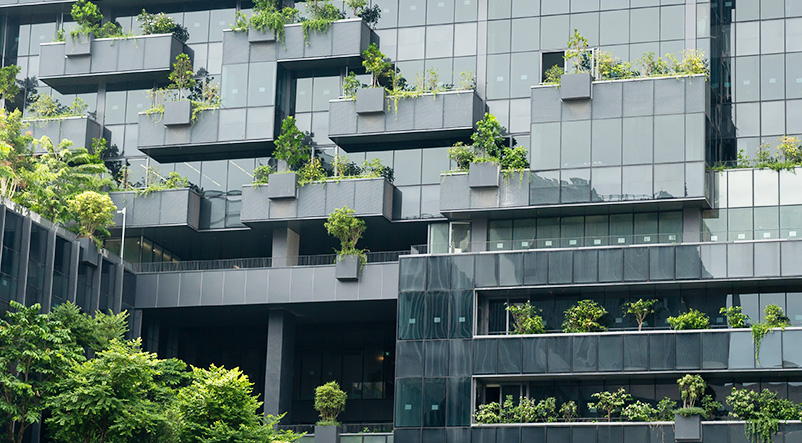
Green or bust: The future of real estate
Real estate investing used to be relatively simple - it was about price and yield. Now it’s on the front line in the race to net zero. We will never hit our carbon net zero targets by 2050 with today’s buildings. They must change, and we have to change our investment approach alongside them. Those assets that aren’t changed soon will risk becoming obsolete and losing value.
Originally published in August 2022
Written by Nina Flitman, Senior Writer, and Adrian Benedict, Head of Real Estate Solutions
Walk around any European city, town, village, or industrial estate and almost every building you pass needs some sort of renovation to support the transition to net zero. To put it in numbers, a report from the Buildings Performance Institute Europe1 (BPIE) in 2017 found that 97.5 per cent of buildings (around 215 million structures) in the EU must be upgraded to meet 2050 targets. Europe’s buildings are responsible for 40% of its energy consumption, more than any other sector, and they account for 36% of the E.U.’s energy-related greenhouse gas (GHG) emissions according to the European Commission2. This is (by any definition) unsustainable.
Some buildings will be knocked down and rebuilt to green standards as part of the natural development process. But as 85% of today’s stock will still be standing in 2050, according to the European Commission3, there is a need to retrofit at scale. Currently, very few buildings undergo this sort of adaptation to meet green standards – fewer than 1% every year in most major markets4 – meaning the pace of work must accelerate dramatically. This offers an opportunity for real estate investors to add a new type of value to assets while also supporting the transition to net zero.
Into the unknown
Not that this opportunity is easy: retrofitting at such a scale has never been tried before and it is daunting. Every aspect of buildings has to be considered to have any chance of meeting decarbonization targets. It starts with the obvious steps of updating the physical specifications by installing clean energy infrastructure and improving the building’s energy efficiency. But it extends to sourcing materials with the smallest embodied carbon profiles that support the transition to the circular economy, and educating occupiers and future owners to encourage the long-term sustainable use of buildings through green leases. Even choosing the right occupiers in the first place is important, given there is little point in creating sustainable buildings if they are used in an unsustainable way.
The changes needed are all-encompassing. To be sustainable, real estate assets should use and protect water resources wisely with rainwater harvesting; they should incorporate waste sorting and segregation facilities into the buildings themselves; and – beyond the physical building itself – owners and occupiers should review the supply chains of all materials and contractors.
These improvements have to be tracked and analyzed to ensure that their impact is real, and that change is happening at sufficient speed and scale to make a difference. All buildings will have to meet the highest green standards, targeting “Excellent” ratings from BREEAM, an alignment with E.U. Taxonomy regulation, and EPC A standardization. These various standards can add up to a bewildering alphabet spaghetti of acronyms, but taken together they create a common lens through which we can efficiently evaluate a property portfolio.
Getting ahead of the risks
Making buildings more sustainable is undoubtedly expensive, but a climate-driven renovation can add value to an asset. Retrofitting assets will future-proof portfolios against upcoming regulatory developments, while improving the infrastructure and meeting emissions targets will reduce the transition and physical risks such as flooding or overheating that could impact valuations.
Buildings after a retrofit also have a far stronger rental profile than their brown counterparts, and even as the pandemic ravaged the market over the last two years, the demand for green buildings has remained strong. They are also still in short supply (BPIE’s report in 2017 showed that less than 3% of the E.U.’s building stock qualified for an “A” Energy Performance Certificate), meaning demand should be sustained for the next decade and beyond. We expect to see a strong early-mover advantage for the industry players who grasp the importance of the transformational process and the value it can create.
An ambitious outlook
Embracing this industry-wide change will mean that investors begin to think beyond the usual risk/return model of financing to incorporate decarbonization goals into their portfolios, seeking investments that will produce both financial performance and a contribution towards a net zero world. To paraphrase a report from the Thinking Ahead Institute5, people want both decent returns and a world worth spending those returns in. This is complex, challenging portfolio operators to meet two objective goals at once, but it is undeniably the future of investing if we are to make a positive contribution to the net zero goal.
Transforming Europe’s real estate portfolio is no easy task. The scale and the potential impact on the financial landscape is huge, and there is no framework for us to follow as we make this leap. But given the potential climate impacts from continuing to emit carbon from buildings, the biggest risk to investors, to the industry and communities is to do nothing at all.
Issued by Fidelity Investments Canada ULC (“FIC”). Unless otherwise stated, all views expressed are those of Fidelity International, which acts as a subadvisor in respect of certain FIC institutional investment products or mandates.
This document is for investment professionals only and should not be relied on by private investors.
This document is provided for information purposes only and is intended only for the person or entity to which it is sent. It must not be reproduced or circulated to any other party without the prior permission of Fidelity.
This document does not constitute a distribution, an offer or solicitation to engage the investment management services of Fidelity, or an offer to buy or sell or the solicitation of any offer to buy or sell any securities in any jurisdiction or country where such distribution or offer is not authorized or would be contrary to local laws or regulations. Fidelity makes no representations that the contents are appropriate for use in all locations or that the transactions or services discussed are available or appropriate for sale or use in all jurisdictions or countries or by all investors or counterparties.
This communication is not directed at and must not be acted on by persons inside the U.S. and is otherwise only directed at persons residing in jurisdictions where the relevant funds are authorized for distribution or where no such authorization is required. Fidelity is not authorized to manage or distribute investment funds or products in, or to provide investment management or advisory services to persons resident in, mainland China. All persons and entities accessing the information do so on their own initiative and are responsible for compliance with applicable local laws and regulations and should consult their professional advisors.
Reference in this document to specific securities should not be interpreted as a recommendation to buy or sell these securities but is included for the purposes of illustration only. Investors should also note that the views expressed may no longer be current and may have already been acted upon by Fidelity. The research and analysis used in this documentation is gathered by Fidelity for its use as an investment manager and may have already been acted upon for its own purposes. This material was created by Fidelity International.
This article has been provided by Fidelity Investments Canada ULC (Fidelity) and is for information purposes only. It comprises, among other things, examples of sustainable investing activities across Fidelity and FIL Limited (Fidelity International) only, current as of August 30, 2022. The article may refer to ESG considerations that Fidelity and Fidelity International may take into account as part of their research or investment process, and is not necessarily reflective of the approach of any other Fidelity Investments company or sub-advisor, such as Fidelity Management & Research Company LLC, FIAM LLC, Geode Capital Management, LLC, and State Street Global Advisors Ltd., to ESG research, stewardship and sustainable investing, either specifically or generally.
Past performance is not a reliable indicator of future results.
This document may contain materials from third parties which are supplied by companies that are not affiliated with any Fidelity entity (third-party content). Fidelity has not been involved in the preparation, adoption or editing of such third-party materials and does not explicitly or implicitly endorse or approve such content.
Fidelity International refers to the group of companies which form the global investment management organization that provides products and services in designated jurisdictions outside of North America. Fidelity, Fidelity International, the Fidelity International logo and F symbol are trademarks of FIL Limited. Fidelity only offers information on products and services and does not provide investment advice based on individual circumstances.
©2022 Fidelity Investments Canada ULC. All rights reserved.
1 “97% of buildings in the EU need to be upgraded,” BPIE (Buildings Performance Institute Europe).
2 “In focus: Energy efficiency in buildings, “European Commission (europa.eu).
3 “Renovation and decarbonisation of buildings, europa.eu.
4 “Buildings – Sustainable Recovery – Analysis,” IEA.
5 IFT_paper. 6 “Climate-beliefs,” thinkingaheadinstitute.org.




